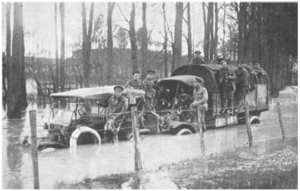Friday, January 8, 1915
In Camp, Lark Hill, Salisbury Plains
The Battalion War Diarist wrote for this day: “Lecture to officers by Lt.-Col. Burland on “Discipline,” and by Gen. McCracken in p.m. on “Active Service.” [1]

THIS DAY IN RMR HISTORY: “(From our Special Correspondent) Salisbury Jan. 8. A glance at the map makes it easy to understand that Salisbury is flooded; and a visit to Salisbury Plain makes it easier still. True, at first sight it seems that there can be no more moisture in the world than that which is collected in the indescribable slush of the ruined roads, the unimaginable mud of the mile upon mile of camp. But such an idea is soon superseded. In every pocket and hollow, even on the high lands, water is lying; the roads may be deep in mud, but ere long we shall find them deeper in water; the huts may be in the state of the body pathetically described by Mr Mantalini, but we shall see houses with the water flowing in reluctant retreat through their front doors.
Upon Salisbury converge three watersheds, beside the mischievous valley of Wylye which approaches it by Wilton. Going westward from Andover, we come first to the Valley of the Bourne, which rises near Collingbourne and flows through Tidworth southwards. At Tidworth the barracks – and of course the kennels – stand out of reach of the flood, but the road is anything from 6 in. to a foot under water; and it is deeper at Park House, once a famous coaching-inn on the London and Exeter road, a few miles further and south of Shipton Bellinger.
IN THE AVON VALLEY: The next valley westward over the Plain is that of the Avon, and here things are considerably worse. In Bulford village the water is deeper than at Tidworth. The churchyard just escapes the flood; but the beautiful old house opposite has its ground floor well under water. Trains of great Canadian motor-wagons may be seen ploughing their way, half ship and half motor, through the little sea; and here is a road-mending van filling in with metal a deep and dangerous hole where the other day an Army hay-wagon lost a wheel. So fierce is the stream by Milsom, or Milstone, Mill, that the road is impassable, and Durrington, where the valley is widest, is shut off from communication on its eastern side. Most of Amesbury, a few miles lower down, lies high, and its fine bridge lifts the road out of danger; but there is more than one spot along the road from Amesbury to Stonehenge where the sea of mud is changed to a sea of clear water.
A POLICEMAN ON STILTS: Westward again lies the small valley which runs from Tilshead through Shrewston to join the Wylye at Stapleford; and Shrewston is one of the places that have suffered most severely. The interesting old Round House stands on an island; the houses along the Amesbury and Andover Roads have all had, or still have, their ground floors flooded. The school only just escapes. It is Shrewston which owns the distinction of a policeman who makes his rounds on stilts; and indeed, stilts or a boat would be the only possible means of getting from one part of Shrewston to another.
From these three valleys, beside the greater valley of the Wylye, water is streaming down upon Salisbury. The flood is abating; but to look up from the watery earth into the watery heavens is not to anticipate any great improvement just at present. [2]
[1] War Diary, 14th Canadian Battalion, The Royal Montreal Regiment, Jan 8, 1915. Library and Archives Canada, Ottawa, http://data2.collectionscanada.ca/e/e044/e001089686.jpg
[2] (The Times, London, Saturday 9 January, 1915) found at: http://www.wiltshire-opc.org.uk/Items/Bulford/Bulford%20-%20Salisbury%20Plain%20in%20Flood%20Time%201915.pdf ©Wiltshire OPC Project/Cathy Sedgwick/2014

